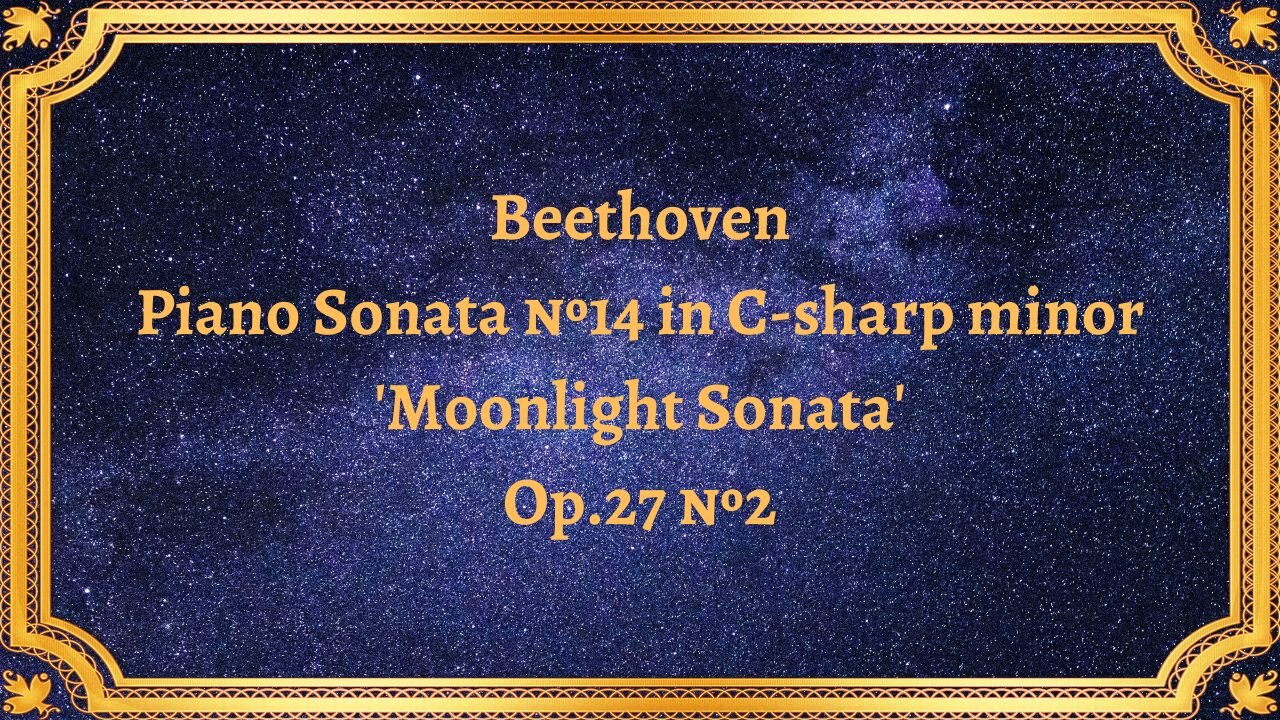Premium Only Content

Beethoven Piano Sonata №14 in C-sharp minor 'Moonlight Sonata', Op.27 №2
#classical_music #Beethoven #Piano_Sonata
Beethoven's Piano Sonata No. 14 in C-sharp minor, Op.27 No. 2, widely known as the "Moonlight Sonata," is a timeless masterpiece that continues to captivate listeners with its ethereal and introspective qualities.
Composed in the early 19th century during the Romantic era, Beethoven's "Moonlight Sonata" holds a significant place in the composer's oeuvre. Published in 1802, it reflects the artistic progression and personal challenges Beethoven faced during that period. The nickname "Moonlight Sonata" was given to it later due to the evocative atmosphere of the first movement.
This sonata consists of three movements: Adagio sostenuto, Allegretto, and Presto agitato. The choice of C-sharp minor as the tonal center lends the sonata a mysterious and haunting quality. Each movement showcases distinct moods and musical characteristics, contributing to the overall narrative of the composition.
The first movement, Adagio sostenuto, is arguably the most famous and recognizable part of the sonata. It begins with a serene and delicate melody, reminiscent of moonlight shimmering on a tranquil lake. Beethoven's use of arpeggios and expressive dynamics creates an otherworldly atmosphere, drawing listeners into a realm of profound introspection.
The second movement, Allegretto, provides a contrasting middle section with a more lighthearted and graceful character. It features a mesmerizing melody that flows effortlessly, accompanied by delicate harmonies. This movement serves as a respite from the intensity of the first movement, offering a glimpse of hope and solace.
The final movement, Presto agitato, bursts forth with passionate intensity. It juxtaposes the tranquility of the previous movements with its rapid and turbulent nature. Beethoven's use of virtuosic passages and dramatic shifts in dynamics creates a sense of urgency and emotional turmoil, leaving a lasting impact on the listener.
Beethoven's "Moonlight Sonata" has left an indelible mark on the world of classical music. Its profound emotional depth, innovative use of dynamics, and lyrical melodies have inspired countless musicians and composers. This iconic composition continues to resonate with audiences of all backgrounds and has been featured in various forms of media, solidifying its status as one of the most beloved and recognizable pieces in the classical repertoire.
Beethoven's Piano Sonata No. 14 in C-sharp minor, Op.27 No. 2, known as the "Moonlight Sonata," stands as a testament to the composer's genius and his ability to evoke deep emotions through music. Its historical significance, captivating structure, and ethereal beauty continue to captivate audiences worldwide. Whether appreciated by music scholars, performed by virtuoso pianists, or embraced by music enthusiasts, this sonata remains a timeless masterpiece that transcends time and space, casting a mesmerizing spell on those who experience its enigmatic allure.
-
 31:06
31:06
Classical music_Music Inspiration
23 days agoPyotr Ilyich Tchaikovsky Piano Concerto No. 1 in B-flat minor
541 -
 DVR
DVR
The Quartering
5 hours agoMMA Fighter Tries To K*LL Wrestler, Hollywood PANIC & Sam Tripoli's Favorite Conspiracies
96.6K128 -
 LIVE
LIVE
Dr Disrespect
4 hours ago🔴LIVE - DR DISRESPECT VS. JEAN-CLAUDE VAN DAMME - HITMAN
1,967 watching -
 1:05:04
1:05:04
Mark Kaye
4 hours ago🔴 Trump Sends Dems Into RAGE Over Flag Burning Executive Order
4.12K5 -
 LIVE
LIVE
The HotSeat
46 minutes agoTrump Drops Hammer: Burn the Flag = 1 Year Prison! Army Deployment Next?!
419 watching -
 LIVE
LIVE
Film Threat
18 hours agoVERSUS: AUGUST BOX OFFICE BLOOD BATH! MARVEL IS COOKED! | Film Threat Versus
56 watching -
 LIVE
LIVE
Jamie Kennedy
18 hours agoThe Truth About Anger, Race, & Feminine Energy w/ Jesse Lee Peterson | Ep 219 HTBITY
52 watching -
![[Ep 734] Leftists Support of Black-on-Black Crime | Bolton Raid / Media Hypocrisy](https://1a-1791.com/video/fww1/0e/s8/1/a/F/p/c/aFpcz.0kob-small-Ep-734-Leftists-Support-of-.jpg) LIVE
LIVE
The Nunn Report - w/ Dan Nunn
1 hour ago[Ep 734] Leftists Support of Black-on-Black Crime | Bolton Raid / Media Hypocrisy
150 watching -
 29:39
29:39
Afshin Rattansi's Going Underground
1 day agoEx-Israeli PM Ehud Olmert: INTOLERABLE Amount of Innocent Palestinians Have Been Killed in Gaza
1.73K24 -
 7:49
7:49
Dr. Nick Zyrowski
6 months agoVitamin D is Dangerous? Get The TRUTH!
3.08K11